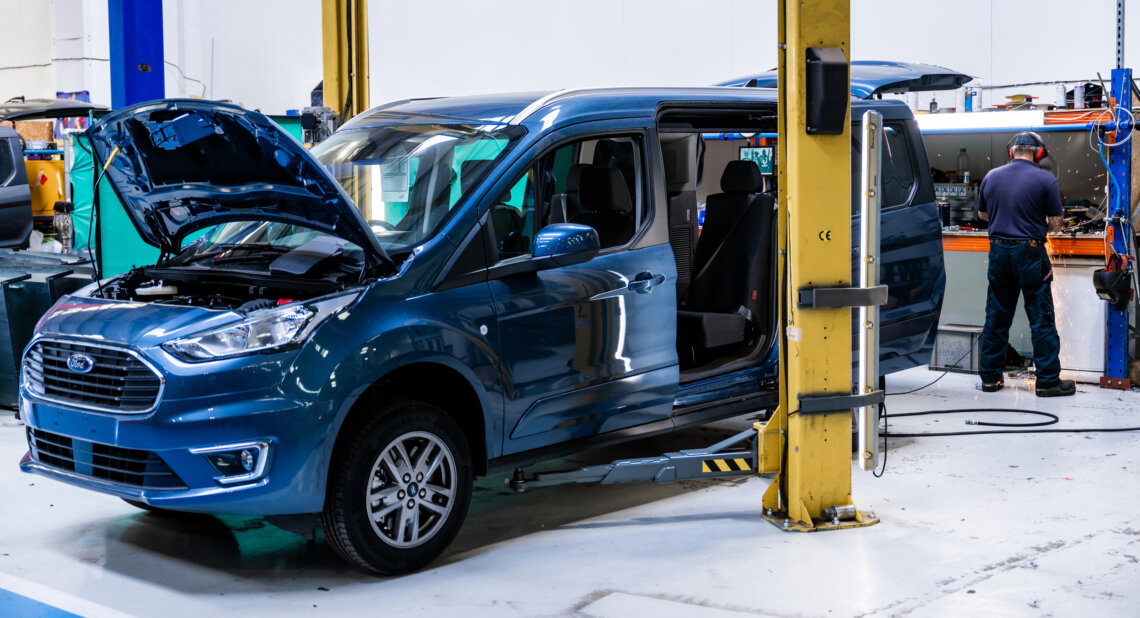Wheelchair Accessible Vehicles (WAVs) are usually converted from commercial vehicles because they are designed to carry large items, giving them a square, spacious rear.
The shape of these vehicles means there’s more room for a wheelchair and the access required to get in and out.
In this article, WAV expert Graham Lloyd* answers some frequently asked questions about WAV conversions for our readers.
- How are vehicles converted for wheelchair access?
- What are the benefits of converting a commercial vehicle to a WAV?
- Can I get a WAV that was originally a standard production car?
- Are there any cars that can be converted but aren’t?
- Will there be changes to the types of vehicles converted in future?
How are vehicles converted for wheelchair access?
Almost all WAVs will have a ramp installed so that the wheelchair user can access the vehicle. The ramp is usually manually operated, although you can get automatic and gas-assisted ramps. Plus, in most conversions the floor in the rear of the vehicle is lowered so that the wheelchair user can sit comfortably in the vehicle. However, in the largest WAVs, converters tend to keep the floor completely flat and instead install a lift to allow access for the wheelchair user.
WAVs are usually converted from commercial vehicles because of their size and shape
What are the benefits of converting a commercial vehicle to a WAV?
There’s more space. Lowering the floor gives the wheelchair user maximum headroom when they’re inside. It also means that they’ll be able to see out of the windows.
If the floor wasn’t lowered, then you could potentially get a wheelchair user inside but they’d be high up and may not be able to see out of any windows, which could make passengers feel travel sick.
Can I get a WAV that was originally a standard production car?
The car industry rarely makes cars the shape you need for a WAV. Most cars are sloped at the rear, so there’s less space and very little headroom for a wheelchair user. The rear of 4X4s are square, but the four-wheel drive system runs through the middle of the vehicle. You can’t cut through the driveshaft to put a lowered floor section in, so it’s not possible to convert a 4X4 to a WAV.
Are there any cars that can be converted but are not?
Multi-purpose vehicles (MPVs) can be converted, but they’re not an ideal shape. Plus, as fewer are made now, they cost thousands of pounds more to convert.
Will there be changes to the types of vehicles converted in future?
Suppliers play a key role in keeping customers mobile, but they are reliant on what the car manufacturers build, as cars are usually designed and developed to meet the needs of the wider retail market.
Electric Vehicles (EVs) will be the next step in terms of incoming base vehicle types. Currently, the placement of the battery pack makes this tricky as most WAVs have the floor lowered for wheelchair access, but we’ll be working closely with partners to find new solutions that will help open up even more choice in the future.
In conclusion, WAVs play a vital role in helping people stay mobile. Converting commercial vehicles is often the most practical way to meet their needs. While there are limitations to what can and cannot be converted, ongoing innovation means the future of WAVs is exciting and promising.
Interested in leasing a WAV through the Motability Scheme?
When you lease a Wheelchair Accessible Vehicle (WAV) with the Motability Scheme, you’re supported throughout your five-year lease.
You’ll get a full package. We’ll cover your insurance, servicing and breakdown, and your MOTs.
Check to see if you’re eligible. It only takes a minute.
*About the author
Graham started working for Motability Operations in 1999, and then moved to the other side of the industry and worked for WAV converters for many years (converters are responsible for changing standard vehicles into wheelchair accessible ones). In 2018, Graham re-joined us and has since worked with a number of Motability Scheme converters.
Related Articles
How to take better care of your Wheelchair Accessible Vehicle (WAV)
How WAV suppliers will support you during your lease
![]()







